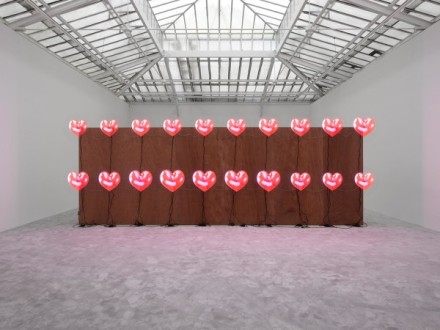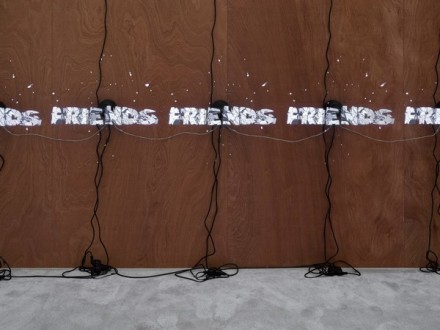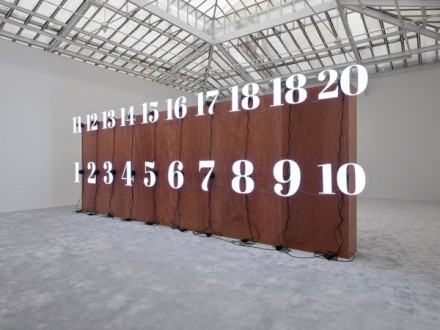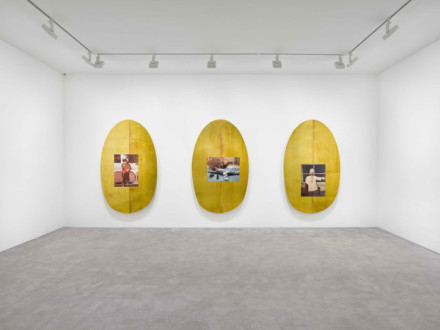
Jordan Wolfson, ARTISTS FRIENDS RACISTS (Installation View), via David Zwirner
Twenty holographic videos and nostalgic photographs printed on brass comprise artist Jordan Wolfson’s latest, unsettling work entitled ARTISTS FRIENDS RACISTS, currently on view at David Zwirner in Paris. Utilizing a range of autobiographical and cultural iconographies, the artist explores the convergent power of images and language in the framing of any cultural epoch.
Showing in the first room of the gallery are a series of wall-mounted brass sculptures with UV substrate prints of photographs of the artist as a child. These brass panels reference classical sculpture, as well as gilded churches and altarpieces from the Middle Ages, overlaid with photographs from his childhood that at once feel anonymous and relatable. The viewer is confronted with an image of youth abstracted from concrete memories, and presented as a religious icon of sorts, a site for meditation and reflection on another’s personal history.

Jordan Wolfson, ARTISTS FRIENDS RACISTS (Installation View), via David Zwirner
These nostalgic references, combined with the heaviness of the brass are juxtaposed by the technology of swirling fans in the adjacent room. After passing through a curtain made of chains into the next room, there stands a large wooden wall with twenty moving holographic images. They are produced by high-speed fans embedded with LED lights that play an 8 minute long video of overwhelming imagery, videos, animations, symbols, and text. The curtain of chains separating the spaces evokes a sensation of claustrophobia, as if locked in with the installation, and the imagery in the next room, hovering over its framing mechanism, presents as unassuming, even cute, while occasionally flickering with fraught and disturbing images. Yet a linear message is detectable.

Jordan Wolfson, ARTISTS FRIENDS RACISTS (Installation View), via David Zwirner
The twenty fans move in a synchronized dance, blinking on and off, sometimes dissolving into numbers, portraits of artists, political figures, and of Wolfson himself. These varied references flash frantically in the gallery, while the words “ARTISTS,” “FRIENDS,” “RACISTS,” “STRESS,” “ANXIETY,” “FEAR” appear sporadically while in other moments, large, broken rocks come crashing down towards the viewer. Animated characters and elements, cohesive with other animations that Wolfson has created in the past, of beating hearts, the world with big eyes and open arms, Stars of David twirling and pointing, a puppy being punished, play between more charged videos of police cars and 9/11 firefighters, all converge in a shared collage. Mirroring an overabundant image economy, these words and symbols mirror the shifting meanings the viewer extracts, changing depending on their contexts, or their absence of context.

Jordan Wolfson, ARTISTS FRIENDS RACISTS (Installation View), via David Zwirner
Wolfson is known for his exploration into the individual’s relationship with the media, technology, and information systems, and particularly through American, contemporary culture. Here, his hypnotic display combines words and symbols with imbued imagery, and places them together into a playful visual that at its violent core induces anxiety, and coaxes dread. The chaotic visuals, flashing and changing, are mesmerizing, as though they had been imprinted deeply in the viewer’s subconscious. Combining these video pieces with his meditative brass icons, Wolfson explores the power that visuals and technology, materials, imagery, and words can have on the mind, and how they can be easily distributed, digested, and misinterpreted
— A. Gilliams
Read more:
Jordan Wolfson: ARTISTS FRIENDS RACISTS [Exhibition Site]



